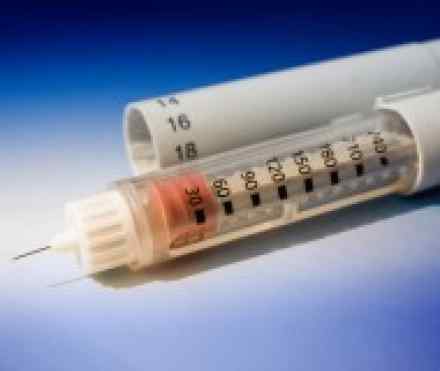-
Increased thirst and frequent urination. As excess sugar builds up in your child's bloodstream, fluid is pulled from the tissues. This may leave your child thirsty. As a result, your child may drink — and urinate — more than usual.
-
Extreme hunger. Without enough insulin to move sugar into your child's cells, your child's muscles and organs become depleted for energy. This triggers intense hunger.
-
Weight loss. Despite eating more than usual to relieve hunger, your child may lose weight — sometimes rapidly. Without the energy sugar supplies, muscle tissues and fat stores simply shrink. Unexplained weight loss is often the first symptom to be noticed.
-
Fatigue. If your child's cells are deprived of sugar, he or she may become tired and lethargic.
-
Irritability or unusual behavior. Children with undiagnosed type 1 diabetes may suddenly seem moody or irritable.
-
Blurred vision. If your child's blood sugar is too high, fluid may be pulled from the lenses of your child's eyes. This may affect your child's ability to focus clearly.
-
Yeast infection. A genital yeast infection may be the first sign of type 1 diabetes in a girl.
In babies and young children, the first indication of type 1 diabetes may be a yeast infection that causes a severe diaper rash that's far worse than the common red, puffy and tender skin rash. In young children and infants, lethargy, dehydration and abdominal pain also may indicate type 1 diabetes.
Causes
The exact cause of type 1 diabetes is unknown. Scientists do know that in most people with type 1 diabetes, the body's own immune system — which normally fights harmful bacteria and viruses — mistakenly destroys the insulin-producing (islet) cells in the pancreas. Genetics may play a role in this process, and exposure to certain viruses may trigger the disease.
Insulin key to sugar entering cells
Whatever the cause, once the islet cells are destroyed, your child will have little or no insulin. Normally, the hormone insulin helps glucose enter your child's cells to provide energy to the muscles and tissues. Insulin comes from the pancreas, a gland located just behind the stomach. When everything is working properly, once you eat, the pancreas secretes insulin into the bloodstream. As insulin circulates, it acts like a key by unlocking microscopic doors that allow sugar to enter the body's cells. Insulin lowers the amount of sugar in the bloodstream, and as the blood sugar level drops, so does the secretion of insulin from the pancreas.
The liver acts as a glucose storage and manufacturing center. When insulin levels are low — when you haven't eaten in a while, for example — the liver releases stored glycogen, which is then converted to glucose to keep your blood glucose level within a normal range.
Dangerous sugar level in bloodstream
In type 1 diabetes, none of this occurs because there's no insulin to let glucose into the cells. So instead of being transported into your child's cells, sugar builds up in your child's bloodstream, where it can cause life-threatening complications.
The cause of type 1 diabetes is different from the more familiar type 2 diabetes. In type 2, the islet cells are still functioning, but the body becomes resistant to insulin or the pancreas doesn't produce enough insulin.
Risk factors
There aren't many known risk factors for type 1 diabetes, though researchers continue to find new possibilities. Some known risk factors include:
-
A family history. Anyone with a parent or siblings with type 1 diabetes has a slightly increased risk of developing the condition.
-
Genetics. The presence of certain genes indicates an increased risk of developing type 1 diabetes. In some cases — usually through a clinical trial — genetic testing can be done to determine if a child who has a family history of type 1 diabetes is at increased risk of developing the condition.
Possible risk factors for type 1 diabetes include:
-
Viral exposure. Exposure to Epstein-Barr virus, coxsackievirus, mumps or cytomegalovirus may trigger the autoimmune destruction of the islet cells, or the virus may directly infect the islet cells.
-
Low vitamin D levels. Research suggests that vitamin D may protect against type 1 diabetes. However, early intake of cow's milk — a common source of vitamin D — has been linked to an increased risk of type 1 diabetes.
-
Other dietary factors. Omega-3 fatty acids may offer some protection against type 1 diabetes, while drinking water that contains nitrates may increase the risk. Additionally, the timing of the introduction of cereal into a baby's diet may affect his or her risk of type 1 diabetes. One clinical trial found that between ages 3 and 7 months appears to be the optimal time for introducing cereal.
Some other possible risk factors include a young maternal age (less than 25), a mother with preeclampsia during pregnancy, and a baby with jaundice or a respiratory infection occurring just after birth.
Complications
Type 1 diabetes can affect nearly every major organ in your child's body, including the heart, blood vessels, nerves, eyes and kidneys. The good news is that keeping your child's blood sugar level close to normal most of the time can dramatically reduce the risk of these complications.
Long-term complications of type 1 diabetes develop gradually. Eventually, if blood sugar levels aren't well controlled, diabetes complications may be disabling or even life-threatening.
-
Heart and blood vessel disease. Diabetes dramatically increases your child's risk of various cardiovascular problems, including coronary artery disease with chest pain (angina), heart attack, stroke, narrowing of the arteries (atherosclerosis) and high blood pressure, later in life.
-
Nerve damage (neuropathy). Excess sugar can injure the walls of the tiny blood vessels (capillaries) that nourish your child's nerves, especially in the legs. This can cause tingling, numbness, burning or pain that may begin at the tips of the toes or fingers and gradually spread upward. Left untreated, your child could lose all sense of feeling in the affected limbs.
-
Kidney damage (nephropathy). The kidneys contain millions of tiny blood vessel clusters that filter waste from your child's blood. Diabetes can damage this delicate filtering system. Severe damage can lead to kidney failure or irreversible end-stage kidney disease, requiring dialysis or a kidney transplant.
-
Eye damage. Diabetes can damage the blood vessels of the retina (diabetic retinopathy). Diabetic retinopathy can cause blindness. Diabetes can also lead to cataracts and a greater risk of glaucoma. By adulthood, diabetes is a leading cause of blindness.
-
Foot damage. Nerve damage in the feet or poor blood flow to the feet increases the risk of various foot complications. Left untreated, cuts and blisters can become serious infections.
-
Skin conditions. Diabetes may leave your child more susceptible to skin problems, including bacterial infections, fungal infections and itching.
-
Osteoporosis. Diabetes may lead to lower than normal bone mineral density, increasing your child's risk of osteoporosis as an adult.
Diagnosis
If your child's doctor suspects diabetes, he or she will recommend a screening test. The primary test used to diagnose diabetes in children is the:
-
Random blood sugar test. A blood sample will be taken at a random time. Blood sugar values are expressed in milligrams per deciliter (mg/dL) or millimoles per liter (mmol/L). Regardless of when your child last ate, a random blood sugar level of 200 mg/dL (11.1 mmol/L) or higher suggests diabetes.
If your child's random blood sugar test results don't suggest diabetes, but your doctor still suspects it because of your child's symptoms, you doctor may do a:
-
Glycated hemoglobin (A1C) test. This blood test indicates an average blood sugar level for the past two to three months. It works by measuring the percentage of blood sugar attached to hemoglobin, the oxygen-carrying protein in red blood cells. The higher the blood sugar levels, the more hemoglobin that has sugar attached. An A1C level of 6.5 percent or higher on two separate tests indicates diabetes. A result between 6 and 6.5 percent is considered prediabetes, which indicates a high risk of developing diabetes.
Another test your doctor might use is a fasting blood sugar test. A blood sample will be taken after an overnight fast. A fasting blood sugar level less than 100 mg/dL (5.6 mmol/L) is normal. A fasting blood sugar level from 100 to 125 mg/dL (5.6 to 6.9 mmol/L) is considered prediabetes. If it's 126 mg/dL (7 mmol/L) or higher on two separate tests, your child will be diagnosed with diabetes.
If your child is diagnosed with diabetes, your doctor will also run blood tests to check for autoantibodies that are common in type 1 diabetes, and help doctors distinguish between type 1 and type 2 diabetes. The presence of ketones — byproducts from the breakdown of fat — in your child's urine also suggests type 1 diabetes, rather than type 2.
After the diagnosis
Once your child has been diagnosed with type 1 diabetes, he or she will regularly visit his or her doctor to ensure good diabetes management.
During these visits, the doctor will also check your child's A1C levels. Your child's target A1C goal may vary depending on his or her age and various other factors, but the American Diabetes Association generally recommends that A1C levels be below 7 percent, which translates to an estimated average glucose of 154 mg/dL (8.5 mmol/L). The American Diabetes Association recently developed a formula to translate the A1C into an estimated average glucose (eAG) because it more closely correlates with daily blood sugar readings.
Compared with repeated daily blood sugar tests, A1C testing better indicates how well your child's diabetes treatment plan is working. An elevated A1C level may signal the need for a change in your child's insulin regimen or meal plan.
In addition to the A1C test, the doctor will also take blood and urine samples periodically to check your child's cholesterol levels, thyroid function, liver function, kidney function and to test for celiac disease. The doctor will also examine your child to assess his or her blood pressure and growth, and will check the sites where your child tests his or her blood sugar and delivers insulin.
References
http://www.mayoclinic.org/diseases-conditions/type-1-diabetes-in-children/basics/definition/con-20029197
https://www.hse.ie/eng/health/az/D/Diabetes,-type-1/
http://www.webmd.com/diabetes/type-1-diabetes-guide/kid-type-1-diabetes






















